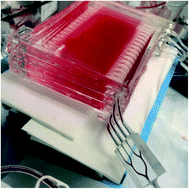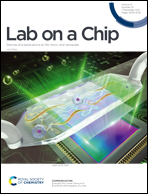Design and construction of three-dimensional physiologically-based vascular branching networks for respiratory assist devices†
Abstract
Microfluidic lab-on-a-chip devices are changing the way that in vitro diagnostics and drug development are conducted, based on the increased precision, miniaturization and efficiency of these systems relative to prior methods. However, the full potential of microfluidics as a platform for therapeutic medical devices such as extracorporeal organ support has not been realized, in part due to limitations in the ability to scale current designs and fabrication techniques toward clinically relevant rates of blood flow. Here we report on a method for designing and fabricating microfluidic devices supporting blood flow rates per layer greater than 10 mL min−1 for respiratory support applications, leveraging advances in precision machining to generate fully three-dimensional physiologically-based branching microchannel networks. The ability of precision machining to create molds with rounded features and smoothly varying channel widths and depths distinguishes the geometry of the microchannel networks described here from all previous reports of microfluidic respiratory assist devices, regarding the ability to mimic vascular blood flow patterns. These devices have been assembled and tested in the laboratory using whole bovine or porcine blood, and in a porcine model to demonstrate efficient gas transfer, blood flow and pressure stability over periods of several hours. This new approach to fabricating and scaling microfluidic devices has the potential to address wide applications in critical care for end-stage organ failure and acute illnesses stemming from respiratory viral infections, traumatic injuries and sepsis.



 Please wait while we load your content...
Please wait while we load your content...